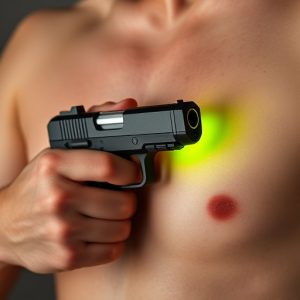Mastering Safe Stun Gun Use: Essential Tips and Skin Contact Considerations
A stun gun is an effective non-lethal self-defense tool that emits an electric shock to temporarily…….
A stun gun is an effective non-lethal self-defense tool that emits an electric shock to temporarily incapacitate an attacker. Contrary to the belief that it must fully penetrate clothing or directly touch skin to work, modern stun guns can deliver a shock without full skin contact; some designs even allow for remote incapacitation via an electric field. It's important for users to understand their stun gun's operation, perform regular maintenance to ensure functionality, and be aware of how environmental factors might affect performance. Legal considerations vary by region, so it's crucial to comply with local laws regarding the use of stun guns. Responsible use also requires comprehensive training to handle the device safely and recognize its effects on the human body, as well as regular practice to maintain proficiency. By understanding the correct use of a stun gun, individuals can effectively defend themselves while minimizing risks associated with the tool's application, ensuring both personal safety and adherence to legal guidelines.
When it comes to personal safety devices, stun guns are a topic of considerable interest and concern. Their role in self-defense is significant, yet their safe and effective use requires knowledge, proper handling, and adherence to legal guidelines. This article delves into the critical aspects of stun gun safety, offering a comprehensive guide that covers understanding the device’s capabilities and limitations, navigating legal restrictions, and ensuring secure storage to prevent unauthorized access. We also explore the importance of training for effective use and clarify common misconceptions about their operation, such as “does a stun gun have to touch skin?” To ensure both your safety and that of others, this piece provides best practices for employing a stun gun, explains its physiological impact on the human body, and outlines necessary steps post-incident, including first aid measures. With these safety tips in mind, you can confidently integrate a stun gun into your self-defense strategy.
Understanding Stun Gun Safety: The Importance of Proper Handling and Usage
When integrating a stun gun into your personal safety measures, it is imperative to familiarize yourself with its operation and the associated safety protocols. A stun gun is a non-lethal self-defense tool designed to incapacitate an attacker by delivering an electric shock. One common question regarding their use is whether the device has to make contact with the skin of the aggressor to be effective. Understanding this aspect is crucial for effective deployment and safety. In most cases, a stun gun does not need to penetrate deep into clothing but should touch the skin sufficiently to transmit the electric current. Proper handling involves regular maintenance checks to ensure the unit is functioning correctly, as well as understanding its limitations—for instance, environmental factors like rain or sweat can affect its performance. Users must also be aware of their surroundings and any potential consequences of using a stun gun, including legal implications that may vary by jurisdiction.
Operators should receive comprehensive training to handle the device responsibly and understand its impact on the human body. Safety precautions include never brandishing a stun gun as a threat in situations where it is not necessary for self-defense, as this could lead to misuse or escalate confrontations. Additionally, practice with the stun gun should be conducted regularly to ensure familiarity and confidence in its use. This practice also helps users understand how the device interacts with different types of clothing and how firmly it must be held against the target. By adhering to these safety tips and understanding the proper way to handle and use a stun gun, individuals can enhance their personal defense strategy while minimizing risks to themselves and others.
When considering stun gun safety, understanding their operation is crucial. A common question regarding stun guns is whether they need to make contact with the skin to be effective. In fact, many modern stun guns are designed to deliver a powerful electric shock upon activation without having to touch the target directly. This feature can be particularly advantageous in self-defense situations where direct contact might not be feasible or safe. It’s important to note that while some models require skin-to-skin contact for optimal effectiveness, others, such as drive-stun guns or stun batons, work by emitting an electric field around them, which can incapacitate an assailant at a distance. When using a stun gun, always adhere to local laws and regulations, and ensure that you are trained in its use to avoid accidental misfires or injuries. Additionally, be aware of the environment and potential risks involved in deploying the device, as environmental factors can affect its performance. Safety measures include keeping your fingers away from probes and understanding the limitations and proper application of the stun gun in self-defense scenarios. Proper usage, understanding the device’s capabilities, and staying informed about legal implications are key components of stun gun safety.


